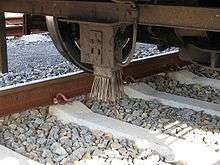Crocodile (train protection system)


A crocodile is a component of a train protection system used in France, Belgium and Luxembourg. It is functionally similar to the Automatic Warning System (AWS) used in United Kingdom.
Communication between the ground-based signalling system and the in-cab equipment is made by the crocodile, an electrical contact placed between the rails (in the four foot way) and a metallic brush mounted beneath the locomotive cab. It is distinctively French, originating on the Chemins de Fer du Nord around 1872, spreading throughout France and penetrating into Belgium and Luxembourg after 1900. It was intended principally to provide evidence of the alertness of the driver, not to act to control a train automatically.
The crocodile is an invention of the engineers Lartigue and Forest. Originally it was placed 100–200 metres in front of a distant signal, usually a red disc of "deferred stop". When recording of cab signals was introduced, the crocodile was moved closer to the signal, often directly opposite it, to reduce the chance of a change of the signal between the time the locomotive passed over the crocodile and when the locomotive actually passed the signal. If a signal changed suddenly to a warning aspect in the face of the driver, it would appear that he had not noticed it and had been surprised, when that was not the case.
The crocodile can send two different pieces of information to the driver, according to the aspect of the corresponding signal:
- The "Répétition Signal Fermé" (which literally means "repetition of closed signal"), corresponding to a warning signal, applies a +20 V voltage to the crocodile causing horn to sound in the driver's cab. Then unless the driver presses a button within five seconds, a penalty brake is applied.
- The "Répétition Signal Ouvert" (which literally means "repetition of opened signal"), corresponding to a cleared signal, applies a -20 V voltage to the crocodile causing a gong to sound in the driver's cab.
References
External links
- Page about the Crocodile and the KVB train protection system (in French)
- An introduction to French cab signals and speed recorders